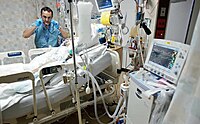
Photo from wikipedia
Type of funding sources: None. Current evidence suggests that incremental levels of PEEP generate an increase in right intracavitary pressures, diminishing venous return and consequently lessening left ventricular preload and… Click to show full abstract
Type of funding sources: None. Current evidence suggests that incremental levels of PEEP generate an increase in right intracavitary pressures, diminishing venous return and consequently lessening left ventricular preload and stroke volume, resulting in a significant decrease of cardiac output. Nonetheless, most studies regarding these interactions have been done in patients requiring mechanical ventilation for non-cardiac disorders or in animals. We studied the effects of incremental levels of PEEP on cardiac intracavitary pressures and hemodynamics in mechanically ventilated patients admitted into the Cardiac Intensive Care Unit. We aimed to model how increments in PEEP alter cardiac output and other hemodynamic variables in patients with cardiac disfunction. We included 14 mechanically ventilated patients admitted into a Cardiac Intensive Care Unit from 2018 to 2020. Data on intracavitary pressures and hemodynamics were recorded via Swan-Ganz catheterization and echocardiographic imaging. We documented measurements for all variables of interest at three different levels of PEEP: 5cmH2O, 10cmH2O and 15cmH2O. We conducted general descriptive statistics, mean comparison tests for paired data and linear regression models with Stata version 12.0 (StataCorp LP, College Station, TX). 7 (50%) patients admitted in the study had cardiogenic shock, 11 (79%) patients were mechanically ventilated in a volume-controlled setting and 3 (21%) were on pressure support ventilation. Seven (50%) patients needed vasoactive drugs during the study. Only 1 (7%) patient required an intra-aortic balloon pump. Seven (50%) patients had a visual left ventricular ejection fraction lesser than 40% and 3 (21%) had a moderate-severe mitral regurgitation. Paired mean testing by groups associated to gains of PEEP revealed statistically significant increments in Mean Pulmonary Artery Pressure (mPAP), Pulmonary Capillary Wedge Pressure (PCWP) and Central Venous Pressure (CVP). Inversely, increments of PEEP were linked to significant decrements in Cardiac Output (CO) [Figure 1 & Table 1]. In mechanically ventilated patients admitted into the Cardiac Intensive Care Unit, rises in PEEP are associated to increments in intracavitary cardiac pressures, and inversely, with decrements in cardiac output. Although our findings are statistically significant, we have yet to clarify whether these are clinically meaningful, specifically within PEEP increments of 5 to 10cmH2O, the usual range in clinical practice.
Journal Title: European Heart Journal: Acute Cardiovascular Care
Year Published: 2023
Link to full text (if available)
Share on Social Media: Sign Up to like & get
recommendations!